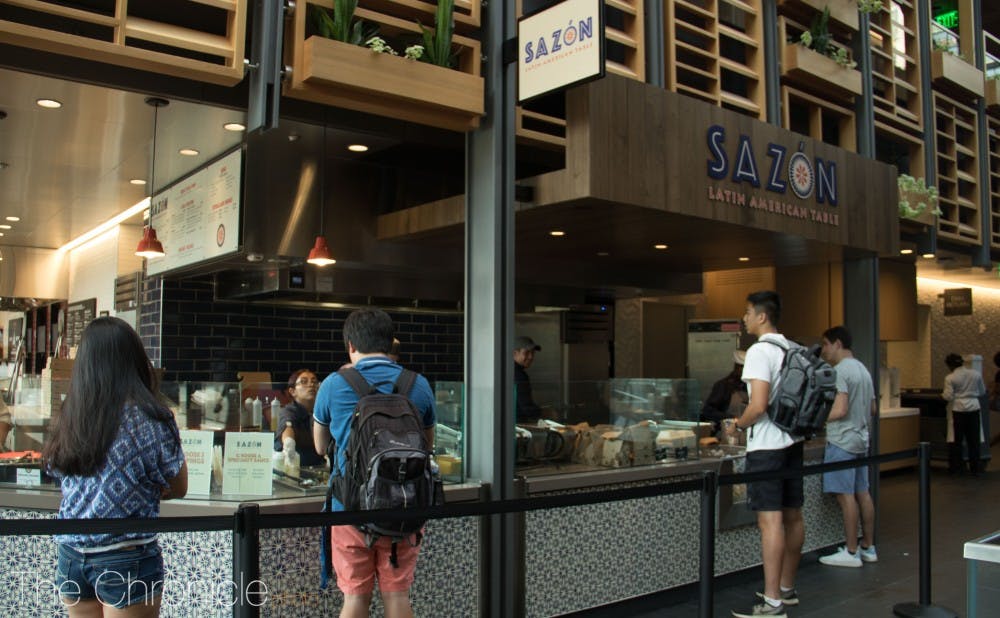Sazón, Duke's first Latin-American inspired restaurant in the Brodhead Center, makes its dining hall debut with long lines, high praise, questionable authenticity and anticipation for more to come.
In its highly anticipated Grand Opening during Duke’s First Big Week, Sazón was packed with students eager to try its fresh Latin-American cuisine, which features dishes inspired by recipes donated by Latin-American students on campus, and to collect the Duke Dining swag bags and free samples.
“We’re amazed at how quickly [Sazón] has caught on,” Scott Morse, owner of both the new restaurant and familiar student-favorite, Il Forno, said at the ribbon-cutting ceremony. “Day one, the line’s formed, and since, we haven’t had 60 seconds where there isn’t a line!”
Student reactions have been mostly positive. Trinity senior Adaír Necalli, an indigenous student from Mexico, enjoyed the food.
“A lot of the food I am pleasantly surprised by, like the yucca fries,” Necalli said. “They actually got the texture right!”
Students have eagerly awaited Sazón’s opening, especially members of the Latinx community on campus, who have worked intimately with the Duke University Student Dining Advisory Committee (DUSDAC) to make Sazón authentic. Many students donated their own recipes and helped pick the name and design of the restaurant and participated in taste tests and focus groups.
Morse has big plans to expand the current menu, including the addition of rotating regional specials based on each country “once things settle down.”
While reviews are fairly positive, common complaints from students are the long lines and high prices.
Trinity senior Lauren Hale said she probably would not go back.
“Just because of the money,” she said. “I don’t have a food plan.”
“The pricing part bothers me the most,” Necalli said. “The pricing was a surprise! [Latinx students] are statistically the least well-off group on campus, and we can’t afford our own food.”
DUSDAC has been in constant contact with Latinx students on campus to ensure that their feedback matters and students’ needs are addressed.
“I do feel like they’ve been open in the process,” Trinity junior Jennifer Ricano said. “They’re trying."
Necalli was quick to assert that Sazón’s authenticity has a special meaning for Latinx students on campus.
“They asked us for authentic recipes and asked us for help to make it an authentic Latino restaurant,” they said. “If they’re aiming for that, they should follow through with it. They promised us.”
Necalli donated their own family’s cherished mole recipe to the restaurant, a recipe they mentioned their brother had spent 15 years coaxing out of their father.
“It’s a lot to give them ‘a responsibility,’” Ricano adds. “At the restaurant, people there are just doing their jobs. But I feel like they’re a stepping stone for people to experience Latin-American culture…Personally, to me, it represents a slice of home.”
Many others also commented on the authenticity.
"I don’t know why the arepa is on the bottom,” Hale, a white student, said.
The arepa bowl, a twist on the pre-Hispanic street food, is one of the restaurant’s main dishes and is usually stuffed instead of mixed in a bowl.
“It doesn’t seem very…authentic," Hale said.
“It’s just very similar to Chipotle.” Ricano said of the same dish. “They’re taking Chipotle and putting their own spin on it [with] the bowls, where they just put in the rice, and the beans, and the cheese…That’s fake Latin-American.”
It also doesn’t help when the servers, only a few of whom are Hispanic, can not pronounce the names of the food. “Yeah, some person ordered a horchata, and the guy kind of stops and says, ‘Wow, it sounds really different when you say it correctly!’” Ricano said.
Necalli recalls an interaction where a Hispanic student corrected the server on their pronunciation. “He wasn’t bothered by it, but, if you’re working at this restaurant, if I order barbacoa, you should know what I’m saying,” they said. “I shouldn’t have to mispronounce my food for you to get it.”
Despite initial hiccups, both Ricano and Necalli express excitement over the future of Sazón, especially the rotating regional menu.
“I would love for people to try menudo or pozoles…and I haven’t tried Venezuelan food or Argentinian food!” Necalli said. “Still, I would like to emphasize the pricing part, though. If anything, at least, this restaurant should change that…and the arepas need to be fixed.”
Get The Chronicle straight to your inbox
Signup for our weekly newsletter. Cancel at any time.

